In the late 80s and early 90s, virtual reality was one of the most promising upcoming new technologies. There was a promise of amazing experiences in exhilarating virtual worlds, and consumers were more than ready for adventures that would blur the border between game and reality. Even the film industry was interested in the idea, which led to cult classics such as The Lawnmower Man and Johnny Mnemonic.
VIRTUAL BOY
In 1995, Nintendo launched Virtual Boy, an attempt to create a virtual reality console for home use. Perhaps Virtual Boy marked the beginning of the end for virtual reality; the first tangible evidence of the serious shortcomings technology had back then, in relation to Virtual Reality. It didn’t live up to the vision of its designers at Nintendo, nor did it please the consumers, who complained of nausea and headaches. Virtual Boy was one of the biggest failures in Nintendo's history, and today it is almost a joke and an example of how not to do things.
The whole industry behind this new phenomenon dubbed virtual reality began to crumble when it became clear that the technology was in no way up for the challenge at hand.
Creating virtual 3D worlds in a time where technology could barely handle two dimensions, and the LCD screens were best suited for pocket calculators, was just too ambitious. Investors deserted the sinking ship with bankruptcies as a result.
It all ended up with virtual reality dying, at least in the world of consumers. In a long time this kind of technology was exclusively for military simulators, medicinal and space research.
THE INEVITABLE FAILURE
In retrospect, it could not have gone any other way. The technology simply wasn’t there yet. LCD displays were by today's standards miserable, with poor resolution and slow response time, making it useless for the purpose.
Modern 3D graphics hadn’t even reached gaming yet at this point in time and the first real 3D first person shooter called ‘Quake’ came a whole year after Virtual Boy failed. 3D graphics was essential for creating realistic virtual worlds. Furthermore, the sensors tracking head rotation were extremely expensive, imprecise and exotic in those days. On top of all these factors, so-called latency was just too significant.
Latency is the time between doing something physical like turning your head or moving your mouse and seeing the result of that happening on the screen. Too much latency causes you to feel disconnected from the virtual world and disoriented, and that leads to something similar to motion sickness and causes headaches and nausea.
SMARTPHONES INVADING PLANET EARTH
Let’s get back to present time, because something has happened in the meantime. Something that pushed development forward at an unprecedented pace in many fields at once. Apple's introduction of the first iPhone created a booming market for smartphones, and the underlying technology behind this phenomenon.
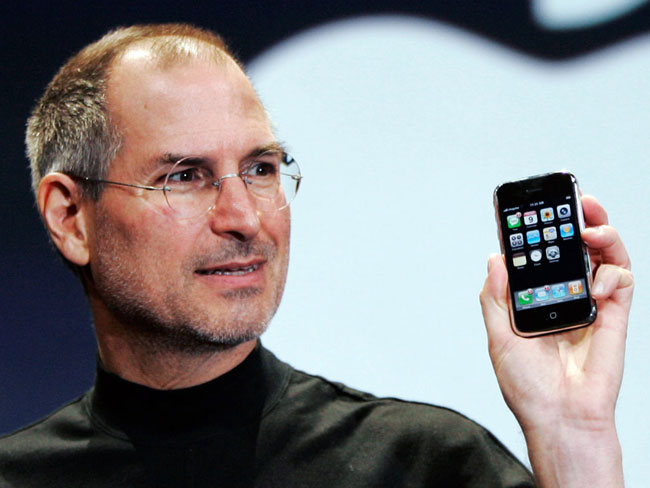
Steve Jobs unveils the iPhone. Pictures: Tapscape.com
This resulted in display technology advancing with leaps and bounds in a very short time, helped along by the introduction of Google's Android platform. At the same time sensors such as magnetometers, accelerometers and gyroscopes become cheaper, smaller and more precise, again thanks to smartphone advancements. Astronomical sums are now being used to develop mobile technology at a furious pace that does not seem to be slowing down any time soon.
Along with this development the gaming industry has undergone huge transition from 2D to 3D, which has pushed graphics and GPU developers forward, making it possible to create 3D graphics that are very close to reality. Even with relative cheap home computers and gaming consoles.
In other words, the advancements in different technologies have solved a big part of the problems that made virtual reality unachievable 20 years ago. The technology has simply matured in some areas that can be used in the development of virtual reality. But no one at that time thought of using this technology to revive virtual reality. Or at least no one has made a serious attempt. Until now.
PALMER LUCKEY, A 19-YEAR-OLD HACKER
In 2010, Palmer Luckey visited the forum MTBS3D.com; a forum on topics about stereoscopic 3D, HMD’s (Head mounted display) and virtual reality. He had a desire to go buy a pair of virtual reality glasses to use with his favorite games. He soon realized that no such products were available and those that were available, certainly did not match the expectations he had.
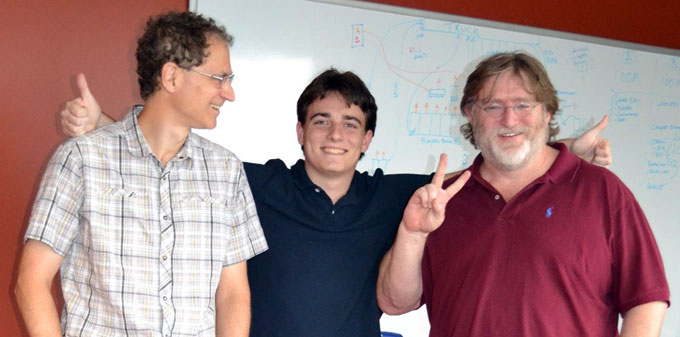
Michael Abrash, Palmer Luckey, Gabe Nevell. Pictures: Airbornegamer.com
Maybe if you had $100,000 dollars you could buy something pretty good, but it still wasn’t what he was looking for and maybe it wasn’t even available for civilians. He simply could not believe that there wasn’t anything out there.
As Palmer had plenty of experience with hacking and rebuilding gaming consoles, being well known in the hardware hacking community, the solution was to try making his own HMD. Palmer began to buy up all existing HMDs he could get his hands on, to find out what worked and what didn’t work. Soon he had a collection of more than 40 models that stretched from home theater models to military technology that once cost $ 100,000. At the same time he obtained all literature he could find about virtual reality, display technology, optics and so on.
TWO EYES – ONE DISPLAY
He got the idea to use a display from a mobile phone, and then split it into two halves, one for each eye. The mobile displays were readily available and cheap. Other HMDs mostly had small and expensive micro display for each eye. By using the same display for both eyes, he solved a lot of problems and created a low cost solution that exploited the advancements in mobile technology.
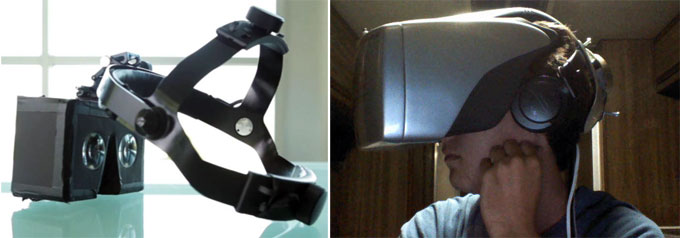
Two of the many prototype made by Palmer. Picture: Roadtovr.com
Using a single display also meant that software could draw two images on the same screen simultaneously, without having to work with advanced frequency synchronization or dual-display setups. This way it wasn't necessary to develop new display drivers, as long as the game or software was configured to render two images at once. The first prototype wasn’t even in 3D, but just the same picture just shown twice, keeping it real simple.
One of the most important aspects of HMDs or virtual reality glasses is to achieve a large field of view or FOV as possible. The bigger it is, the easier the brain will accept the new reality, resulting in more immersion. Palmers solution was to use some powerful lenses in front of each eye, similar to fisheye lenses. In this way, the screen is almost wrapped around your FOV, a bit like in an IMAX theatre.
The lens also creates an illusion of the screen being several feet away, and thereby relaxes your eyes. Actually your eyes are in a more relaxed and natural state than while looking on a 2D monitor. However, the method also causes the occurrence of extreme distortion. But when you do not have access to extremely expensive optics, you just have to live with the distortion. Palmer added some standard accelerometers and gyroscopes so that the viewing direction could be translated into the virtual world, thus creating a cheap and efficient virtual reality HMD.
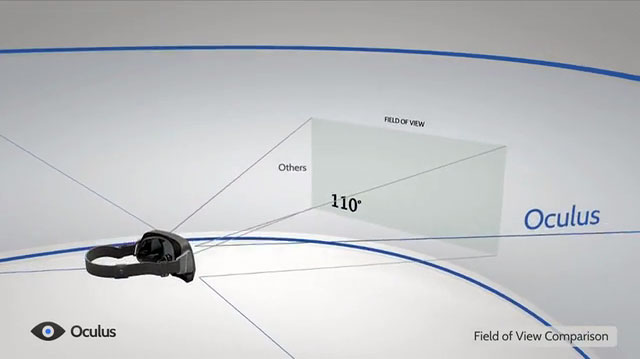
Oculus Rift FOV compared to other systems. Picture: OculusVR.com
JOHN CARMACK - CREATOR OF DOOM AND QUAKE
Virtual reality has been one of John Carmack’s passions since he created Quake in 1996, along with Michael Abrash and John Romero. At the same time Palmer Luckey finished his sixth prototype, which he named Oculus Rift, John Carmack visited the MTBS3D forum. John was considering building a HMD himself. Like Palmer, he had learned that he could buy what he wanted, despite having much greater resources than Palmer, including more money and contacts in the space industry.
He found the forum where Palmer blogged about his Oculus Rift project and realized that this was exactly what he wanted. It was better than anything he could buy. Carmack wrote an email to Palmer and asked if he could buy another copy of the Rift. But being one of the most influential people in the game industry, Palmer gave Carmack his only prototype and required no payment for it. This should prove to be an important moment in the history of Oculus Rift and maybe even the future of virtual reality.
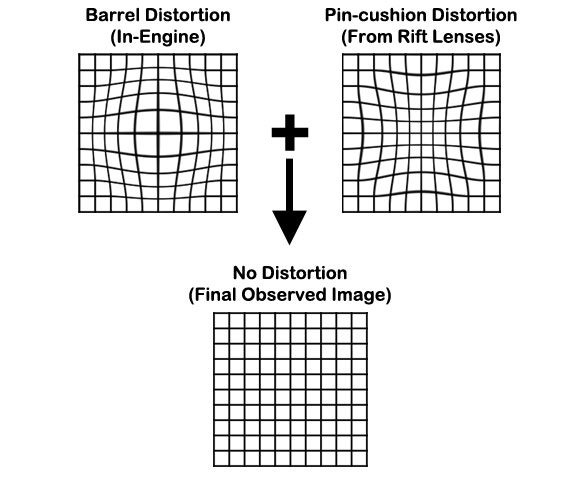
The opposite distortions cancels each other out, but the big FOV is intact - Gamesutra.com
CARMACK BRINGS OCULUS RIFT TO E3
John Carmack really enjoyed the Oculus Rift. In the course of a single day, he made Doom III compatible with it and wrote an OpenGL warp shader, compensating for the distortion directly in the software. He resolved a problem with relative simple software and the work of modern GPU shaders that used to be unsolvable with the most expensive optics. A simple and brilliant solution thanks to the advancements of modern GPUs.
He was so excited with the result that he brought the Oculus Rift prototype with him to the E3 trade show in 2012. He let journalists try Doom III BFG with Oculus Rift prototype and reception was fantastic. It was clear to everybody that this was something special.
With Oculus Rift you could get right into the game in a way no one had experienced before. Oculus Rift was nominated "Best of Show" by several blogs and magazines, despite being a prototype made from foam and duct tape.
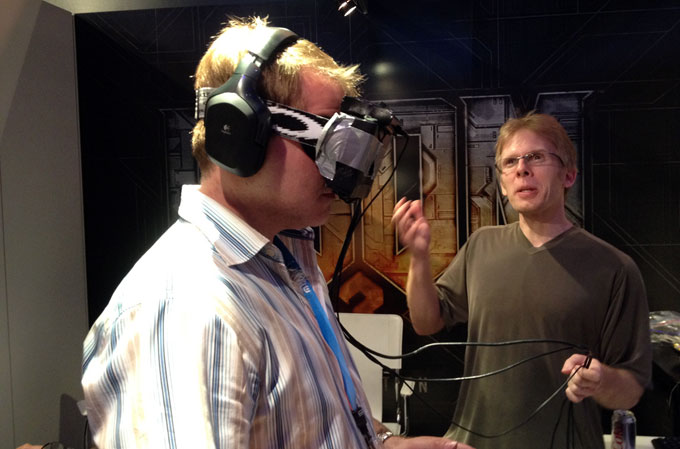
John Carmack brings prototype to E3 2012 - OculusRift-Blog.com
BECOMING A COMMERCIAL PRODUCT
Palmer realized that Oculus Rift had the potential to become a successful commercial product, and with the help of Brendan Iribe, who had two start-up successes behind him, he founded the Oculus VR. A few industry veterans and friends were hired too.
The team launched a Kickstarter campaign starting August 2012. He got some of the most respected people in the game industry to appear in a presentation video to support the product. Among them was John Carmack, Cliff Bleszinski and Gabe Nevell, owner of Valve and the Steam network. Oculus VR needed $250,000 to create the development kit, but the campaign generated a staggering $2.5 million and more than 7500 development kits were sold, along with many more in the following months after the Kickstarter campaign ended. John Carmack also brought the prototype to QuakeCon later in August 2012 during the Kickstarter campaign and this probably helped boost the campaign even further.
So what began as a rough prototype that only concerned the most hardcore virtual reality enthusiasts now became big business, with great commercial potential. The development kit is intended to give developers across the world an opportunity to create games and software for the Oculus Rift, so there will be plenty of content when the consumer version is launched to the public sometime in 2014 (date not officially confirmed).
It's been almost a year since the Kickstarter campaign ended, and Oculus VR has been in constant growth ever since, hiring and headhunting some of the best people in the business. Very recently a couple of private mutual foundations invested an additional $16 million in Oculus VR to get a consumer model made ready for retail even faster.
Oculus Rift has grown to become one of the most hyped topics in the gaming industry over the past year, and has in many ways become synonymous with virtual reality. Welcome to the future.
 Oculus Rift - Back to the Future">
Oculus Rift - Back to the Future">






